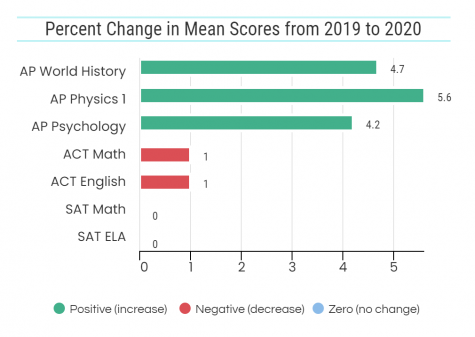[Opinion] Colleges should be lenient in assessing exam scores influenced by the pandemic
Jackpot. Intently studying a chapter of her textbook, a girl hopes that the material is covered in her soon-to-come Advanced Placement exam. The shorter AP exam formats of 2020 covered only a select unit of information, leaving much of the curriculum unassessed. Graphic by Angela Guiso.
April 27, 2021
Once again, that time of year looms near. Many students are joining last year’s test-takers in facing the unique challenge of final exams during the COVID-19 pandemic, influenced by the in-school to at-home shift in both curriculum and assessment structure. For those who seek to enroll in colleges and universities, factors influencing test-taking are all the more critical to heed.
Postsecondary institutions use these scores to gauge a student’s readiness and proficiency, regardless of the circumstances surrounding these assessments. While colleges and universities should not be lenient on scores achieved in the 2021 SAT, ACT and AP exams, they should be lenient on scores and the lack thereof in 2020, as many students were highly impacted by societal unrest, exam cancellations and rescheduling, and exam formats that improperly gauged a student’s proficiency.
In regards to the 2020 AP exams, media coverage and public opinion were generally negative, as seen by the long list of protesting videos, reports and articles. Interestingly enough, these criticisms emerged despite the exams’ overall consistent scores relative to the 2019 AP exams.

Sources: SAT Results Report 2020, SAT Results Report 2019, ACT Results Report, AP Exam Results Report 2019, AP Exam Results Report 2020.
This is due to the simplified structure of exams such as the AP World History assessment, which consisted of a single document-based question based on a specific unit. Ignoring the technical problems and inconveniences that arose, students were only able to demonstrate their proficiency in a highly specific category, regardless of their overall knowledge of world history, and regardless of if they favored other test formats such as multiple-choice questions or different types of essay questions.
Although postsecondary institutions should take into account the 2020 AP exams’ shortcomings, these exams’ ineptitude in assessing students does not translate into this year’s exams, as seen by the return to the more traditional, longer formatting. The virtual exam options also provide for fairness in test-taking and proper coverage of the curriculum via adjustments, such as types of questions and material covered.
In both 2020 and 2021, the SAT and ACT exam formats were relatively uninfluenced by the COVID-19 pandemic, as seen by the SAT’s sole offering of in-person tests and the ACT’s consistently balanced format whether online or in-person. Additionally, the grading system for the SAT and ACT includes a curve based on tests’ differences, in order to account for fluctuations in levels of difficulty between tests.
Despite these exams’ reliable formats, issues arose in the actual scheduling of these tests, as many students were unable to take the SAT and ACT in time to submit their scores to postsecondary institutions in 2020. Although students were not at fault for these cancellations and reschedulings, they still bore the burden of adjusting their plans to either select a college that didn’t require these scores or take a gap year.
While the coronavirus pandemic has prompted many postsecondary institutions to drop the requirement of SAT or ACT scores for enrollment, the growing irrelevance of these exams due to disuse in gauging a student’s admission is also a trend that occurred before the pandemic and is a trend that will likely continue in the future.
This is due to allegations of these tests not being correlated with a student’s success in college or university, and being more related to income due to wealthier students’ access to better resources. However, since few other major standardized tests exist, the only alternative is solely relying on values such as a student’s extracurriculars and GPA.
The problem that then arises is that since one’s GPA is based on their teachers’ policies on grading their academic work, using it as a standalone value to signify a student’s abilities ignores the possibility of relying on unequally distributed values due to lack of a standardized grading scale and erroneous judgment.
Thus, in order to accommodate students who do not have SAT and ACT scores, postsecondary institutions have to practice flexibility in utilizing a wide range of values in addition to a student’s GPA, such as other academic scores, extracurriculars, recommendations, interviews, awards and so on.
Additionally, a broader issue that impacts education during the coronavirus pandemic is the psychological strain upon society. This emerges in the form of magnified mental health issues such as anxiety, depression and stress due to dependencies like providing for one’s family or dealing with illness. These obstacles ultimately discourage students’ concentration on studying and preparation for one’s assessments, which can lead to lower scores.
However, that is not to say that there are no opportunities for students to succeed despite the obstacles in their path. Advancements in technology have allowed students to have access to free, high-quality resources for studying, such as Khan Academy and educational Youtube videos. Additionally, many schools have organized helpful programs for financial assistance, college readiness, subject reviews and mental health meetings with counselors and therapists.
There is no denying that in times of crisis such as these, it’s challenging to stay focused and put effort into studying for exams, no matter if they are in-person or virtual. However, this allows for students to practice discipline and hone their concentration, which provides for their future by improving their scores and their ability to persevere through high-pressure situations.
In order for students to do so, colleges and universities need to analyze and understand how changing formats for education and test-taking influence students’ scores, and use that information to better approach discrepancies in assessments, whether that be by improving their exam formats or their method of evaluating students’ admissions.






















